The dropshipping landscape in 2025 is more competitive and dynamic than ever. Success no longer hinges only on finding a winning product or opening a storefront – it also requires leveraging the right dropshipping tools to streamline operations, delight customers, and scale efficiently. We’ll explore the best dropshipping tools across various categories (from product research to fulfillment and marketing) that can help grow your online store in 2025. We’ll also dive into why each type of tool matters and how to choose the right ones for your business. Let’s get started!
What is a Dropshipping Tool?
Dropshipping tools encompass a broad ecosystem of software and platforms designed to help you launch, run, and grow a dropshipping business with less effort. At their core, these tools automate or simplify key e-commerce processes – from product sourcing and importation to order fulfillment, tracking, and marketing. Instead of one single app that does everything, you’ll use a stack of specialized tools, each focusing on a part of your workflow.
For example, some tools help you find trending products, others let you import products to your store in one click and automatically send orders to suppliers, and yet others help you market to customers or analyze your sales. What they all have in common is the goal of saving you time and reducing errors by handling the repetitive or complex tasks for you. In short, a dropshipping tool is any application or service that makes it easier to build a successful dropshipping business by automating processes, providing data insights, or improving the customer experience.
Why You Need the Right Dropshipping Tools
Running an online store involves juggling many tasks – product research, supplier communications, website updates, order processing, customer service, marketing, and more. Trying to do all of this manually is a one-way ticket to burnout. The right dropshipping tools act as “force multipliers” for your business, handling the heavy lifting in the background so you can focus on strategic activities like marketing and customer relationships.
Here are a few reasons why using the proper tools is essential:
-
Efficiency and Automation: Dropshipping software can automate time-consuming tasks like syncing inventory, placing orders, updating tracking numbers, and even adjusting prices. For example, using an all-in-one automation platform like CJdropshipping can sync stock levels and process orders in real-time, meaning your store keeps running smoothly even when you’re not actively working on it. This level of efficiency is hard to achieve without dedicated tools.
-
Accuracy and Scale: As your order volume grows, manually fulfilling each order or updating each price becomes impractical and error-prone. Tools ensure accurate, consistent operations at scale. A fulfillment app can process hundreds of orders with one click, or a pricing tool can instantly react to market changes – things no human could do as reliably or quickly.
-
Competitive Advantage: 2025’s e-commerce space is highly competitive. Those who harness data and automation have a clear edge. Product research tools help identify winning products before they saturate the market. Marketing tools enable personalized campaigns that increase retention. Analytics tools reveal opportunities to optimize conversion rates. In short, the right toolkit helps you make data-driven decisions and serve customers better, which is crucial to stand out from the crowd.
-
Time to Focus on Growth: By automating the “busywork,” dropshipping tools free up your time. Instead of spending hours daily on rote tasks (like copying order details or tracking packages), you can invest that time into growth activities – launching new ad campaigns, refining your site, negotiating better deals with suppliers, or expanding to new markets. This is how small operations grow into substantial brands.
In summary, smart dropshippers treat software tools as an integral part of their business. As one industry expert put it, “the right dropshipping software is more than just a tool: it’s a game-changer”, enabling you to launch faster, avoid mistakes, and scale smarter. Now, let’s explore specific categories of dropshipping tools and some of the top options in each category.
Product Research & Sourcing Tools
One of the first challenges in dropshipping is deciding what products to sell and where to source them. Product research and sourcing tools help you discover trending or high-potential products and connect with reliable suppliers. Rather than guessing or relying on intuition, these tools use data – from social media trends to competitor analysis – to pinpoint winning products that are likely to sell well.
1. CJdropshipping – All-in-One Sourcing Platform
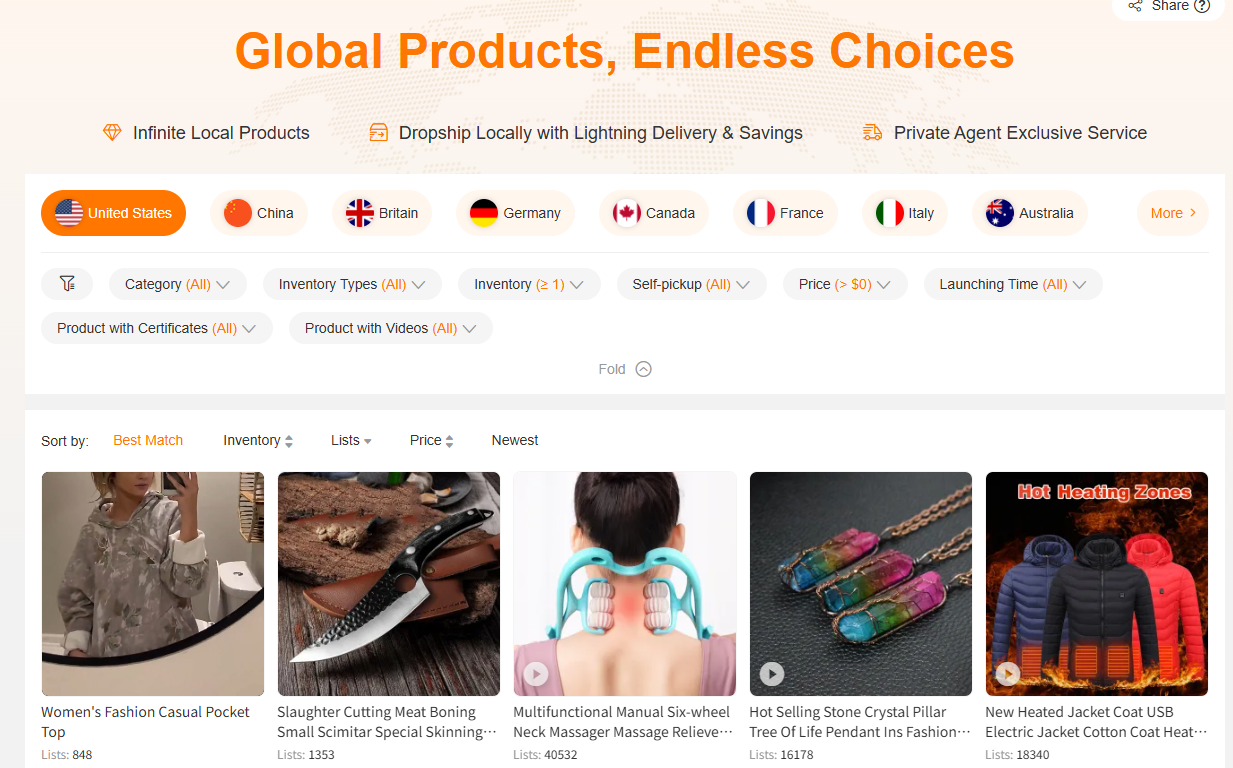
CJdropshipping (often just called “CJ”) is more than just a supplier; it’s a versatile platform that covers product sourcing, warehousing, and fulfillment. For product research, CJ offers a catalog of around 400,000 products across virtually every niche, which you can browse by category, popularity, or new arrivals. Uniquely, CJ even allows you to submit product sourcing requests – if you can’t find a product, they will try to source it for you from their network. This is incredibly useful if you’ve spotted a trending item elsewhere (say, on TikTok or Amazon) and want a supplier for it.
CJdropshipping’s platform also highlights trending products with labels like “Hot” or provides a list of trending categories (their blog frequently posts “top products” lists based on real sales data). A smart strategy is to use external trend signals (e.g. TikTok #MadeMeBuyIt videos or Facebook ad spy tools) to find a product, then search for it on CJ. Because CJ works with factories and wholesale markets (like 1688 or Taobao), their prices can be very competitive. In short, CJdropshipping is both a product research and sourcing tool: it provides the data (top sellers, inventory levels, etc.) and the direct sourcing in one place. Plus, with warehouses worldwide, once you find a product, you can often choose to source it from a local warehouse for faster shipping (more on that later).
2. Minea – Ad Spy and Product Research Tool

Minea has quickly become one of the most powerful tools for finding winning products through social media analytics. It’s essentially an ad spy platform – Minea’s crawlers constantly scrape millions of ads from Facebook, Instagram, Pinterest, TikTok, and more, then store them in a searchable database. Why is this useful? Because successful dropshipping products are often promoted heavily via social ads. Minea allows you to browse and filter these ads to identify products that are getting a lot of traction. You can filter by platform, date, engagement (likes, shares), audience country, and even e-commerce platform of the ad (to see, for example, only ads from Shopify stores).
Beyond ads, Minea also lets you explore what specific stores are selling – its “Browse shops” feature reveals popular products in those stores. It essentially turns publicly available data into actionable insights. You can see which products have many different stores advertising them (a sign of a hot trend), or which ads have unusually high engagement (indicating a potentially winning product). Minea even provides competitor analysis, showing you a given store’s best-sellers, their ad campaigns, and even their pricing strategies. All this information simplifies decision-making by grounding it in data, not guesswork. For instance, if you notice a particular gadget being advertised heavily and getting tons of comments, you could confidently test that product yourself. Minea essentially answers: “What products are currently viral or scaling up via ads?” – a crucial insight for product research.
3. Tradelle – AI-Powered Product Research & Supplier Platform
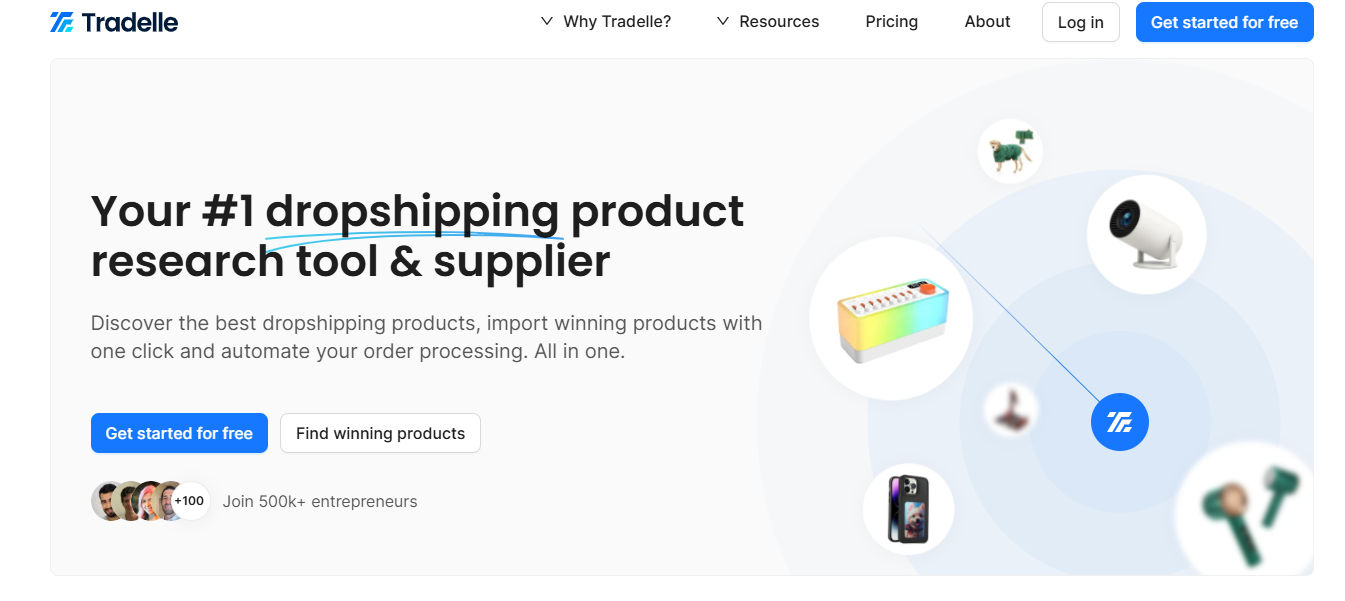
Tradelle is a newer all-in-one dropshipping platform that combines AI-driven product research with built-in supplier and fulfillment services. It’s designed to take a lot of the guesswork out of finding products. Tradelle’s core idea is that the best product research tools shouldn’t rely on random guesses; Tradelle uses advanced web crawlers and big data analytics (developed by in-house AI specialists) to identify products with high potential, and it validates all data transparently. In practice, Tradelle will show you a curated list of “winning products” or trending items, complete with analytics on why they’re performing, how saturated they are, and even geographic demand data for each product (so you can see where an item is hot).
What sets Tradelle apart is that once you find a promising product on their platform, you can source it directly through Tradelle itself. Tradelle functions as a dropshipping supplier too, with automated fulfillment built-in. You connect your store (e.g. Shopify) to Tradelle, and when you start selling a product, Tradelle will automatically ship out the orders to your customers, updating tracking info as well. Essentially, it eliminates the need to separately find a supplier on AliExpress or CJ – it’s all handled in one place. This makes it very beginner-friendly (“suitable for beginners… Tradelle does the work for you” as they state). Tradelle even handles tricky operational aspects like dealing with customs or regulatory challenges, acting as a 3PL so you don’t have to manually manage those details.
In summary, product research tools like Minea and Tradelle help you decide what to sell by providing market-driven insights (trending ads, data-validated product picks), while platforms like CJdropshipping not only help you find products but also serve as the channel to source and fulfill those items. Many successful dropshippers use these in combination – for example, identify a product via Minea’s ad spy, then source it through CJ or Tradelle for fulfillment. Using such tools can dramatically increase your odds of picking winners and getting them to market quickly.
Import & Order Automation Tools
Once you’ve identified some great products to sell, the next challenge is getting them into your online store and fulfilling orders efficiently. This is where import and order automation tools come in. These tools connect your store with suppliers and automate the process of listing products and processing orders. Instead of manually copying product info or placing orders one by one, you can let the software handle it – which is vital for scaling.
1. CJdropshipping – Store Integration & One-Click Import
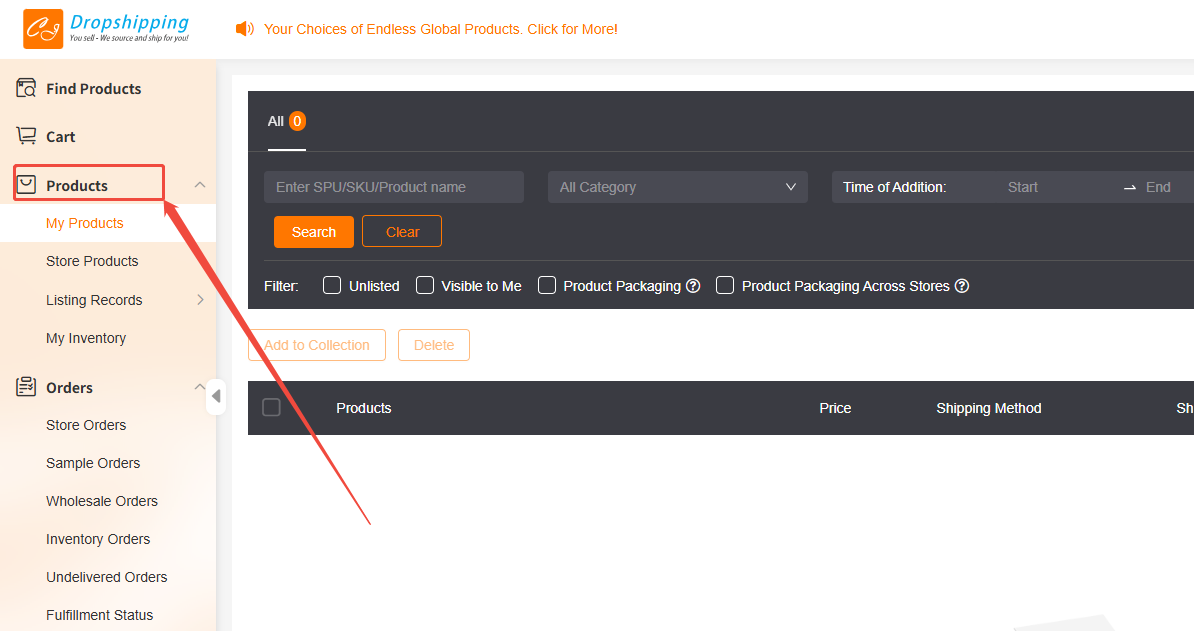
We’ve mentioned CJdropshipping as a sourcing platform, but it’s also an import and fulfillment tool thanks to its tight integrations with e-commerce platforms. CJ has official integrations with Shopify, WooCommerce, eBay, Wix, BigCommerce, and more. Using the CJ app on Shopify (for example), you can import products from CJ’s marketplace to your store with one click – all the images, variants, descriptions, and prices come along automatically. This is a huge time-saver. You can edit the details if needed, then publish the product to your storefront without manual copy-pasting. When an order comes in, the CJ app can automatically trigger fulfillment: the order data is sent to CJ, they pick & pack the item, ship it, and even sync the tracking number back to your store. In effect, CJdropshipping’s integration automates the entire order flow – you “sell” and they handle the rest.
One notable benefit of CJ’s automation is the inventory management. They update you on inventory levels in real-time and even provide a Supplier Optimizer-like function within their platform (similar to DSers, CJ can suggest alternate suppliers for a product if one runs low, though CJ often is the direct source). Also, CJ’s system can consolidate orders (if one customer buys multiple CJ products, they attempt to ship them together) and even automatically route orders to the nearest warehouse for faster delivery. All of these features reduce the manual work you’d otherwise do in coordinating orders. For a beginner, using CJ’s app means you can pretty much run your store’s back-end on autopilot after the initial product listing – orders sync, tracking updates go out, and so on, with minimal intervention.
2. AutoDS – All-in-One Dropshipping Automation Platform
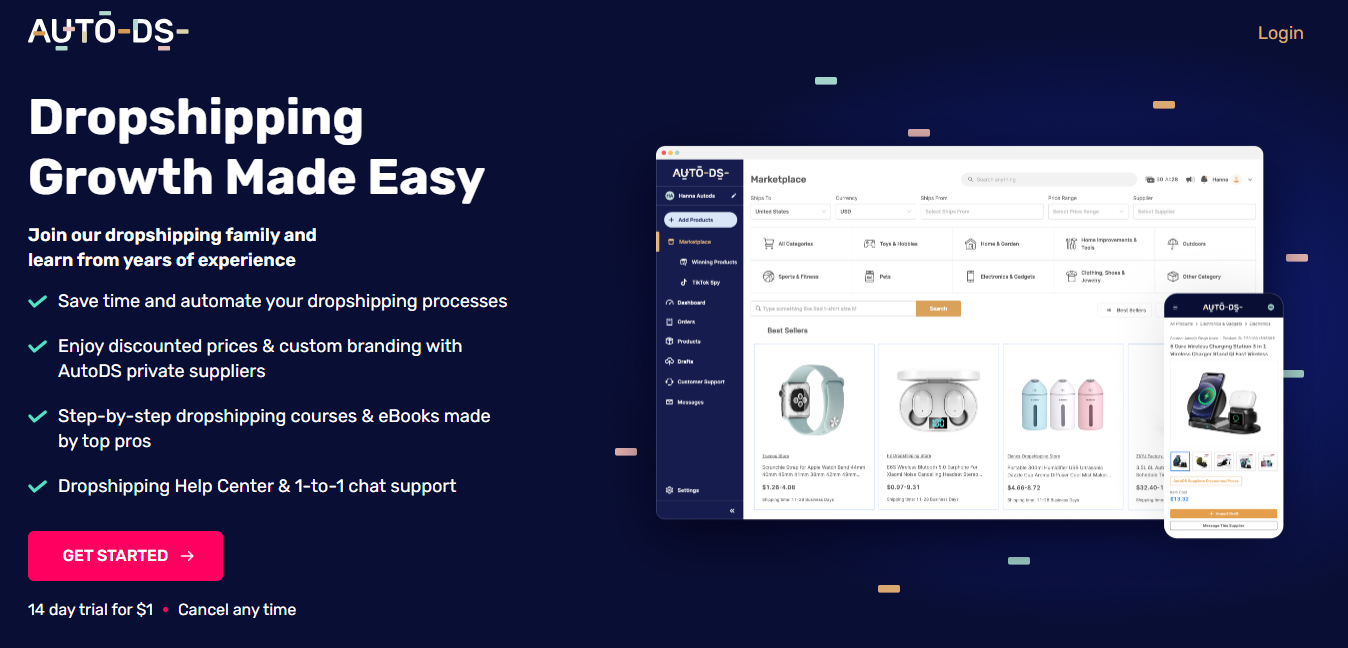
AutoDS is a popular tool that lives up to its name by automating many aspects of dropshipping across multiple suppliers and selling channels. It’s often called an all-in-one automation software because it handles product importing, price and stock monitoring, order fulfillment, and even some product research functions in one dashboard. With AutoDS, you aren’t limited to one supplier – it supports dozens of sources (AliExpress, Amazon, Walmart, HomeDepot, CJdropshipping, and more) and multiple selling platforms (Shopify, eBay, Facebook Marketplace, etc.). This makes it a flexible central hub if you source from various places.
Key features of AutoDS include: one-click product importing (via a URL or a Chrome extension), automatic inventory sync (if a supplier’s stock or price changes, your listing updates accordingly), and automatic order fulfillment. AutoDS can even auto-order from certain suppliers on your behalf. For instance, if you have an Amazon product linked, when you get a sale, AutoDS can automatically purchase that item from Amazon and ship it to your customer (using saved account details) – completely hands-free. It also offers a unified order management dashboard, so if you’re dropshipping from 5 different suppliers, you can still see all orders in one place and track their statuses.
3. DSers – AliExpress Bulk Ordering & Automation

DSers is a tool that rose to prominence as the official replacement for Oberlo (Shopify’s former dropshipping app) and is now the go-to solution for AliExpress dropshipping. If your sourcing strategy revolves around AliExpress suppliers, DSers is arguably essential. Its standout feature is the ability to place hundreds of orders to AliExpress in seconds, instead of manually checkout one by one. This “Bulk Order” functionality is often called legendary – DSers can process hundreds of AliExpress orders in minutes, a game-changer when you have a winning product scaling up. It literally automates the checkout process on AliExpress for you, entering customer addresses and payment details, so you don’t have to touch each order. This alone can save hours of work and avoid mistakes in customer info.
DSers also has a Supplier Optimizer tool built in. This feature will analyze identical products on AliExpress and let you swap to a better supplier with one click (for example, one with a lower price or faster shipping rating), which helps maintain your margins and quality. Additionally, DSers handles tracking number syncing: as the AliExpress seller updates the order status to shipped and adds tracking, DSers automatically pulls that into your store and marks the order as fulfilled with tracking. This spares you from manually checking AliExpress for each order’s tracking info. Inventory and price monitoring is another benefit – DSers will alert you or auto-update if an AliExpress listing goes out of stock or changes price, preventing you from selling something that’s unavailable.
In summary, import and order automation tools are what turn your dropshipping store into a scalable operation. A tool like CJdropshipping’s app or DSers means that when you get 50 orders overnight, you’re not waking up to a nightmare of manual work – the system will handle it or at least make it a few clicks instead of 50 separate actions. Whether you choose an all-in-one like AutoDS or a specialized app like DSers largely depends on your supplier choices and business model. The bottom line is: these tools save you from the tedium of data entry and order coordination, which not only saves time but also greatly reduces errors (no more mistyped addresses or forgotten tracking numbers). This keeps customers happier and your stress level lower.
Fulfillment, Warehousing & 3PL Solutions
As your store grows, you may start considering faster shipping times, better branding, or holding inventory of best-sellers. You might also want suppliers outside of China for certain products. This is where fulfillment solutions and 3PL (third-party logistics) services come in. These tools and platforms help with the physical side of dropshipping – warehousing goods closer to your customers, managing inventory, and ensuring reliable fulfillment. They can bridge the gap between pure dropshipping and traditional e-commerce by adding elements of inventory management, but without you handling it personally.
1.CJdropshipping – Global Warehouses and 3PL Services
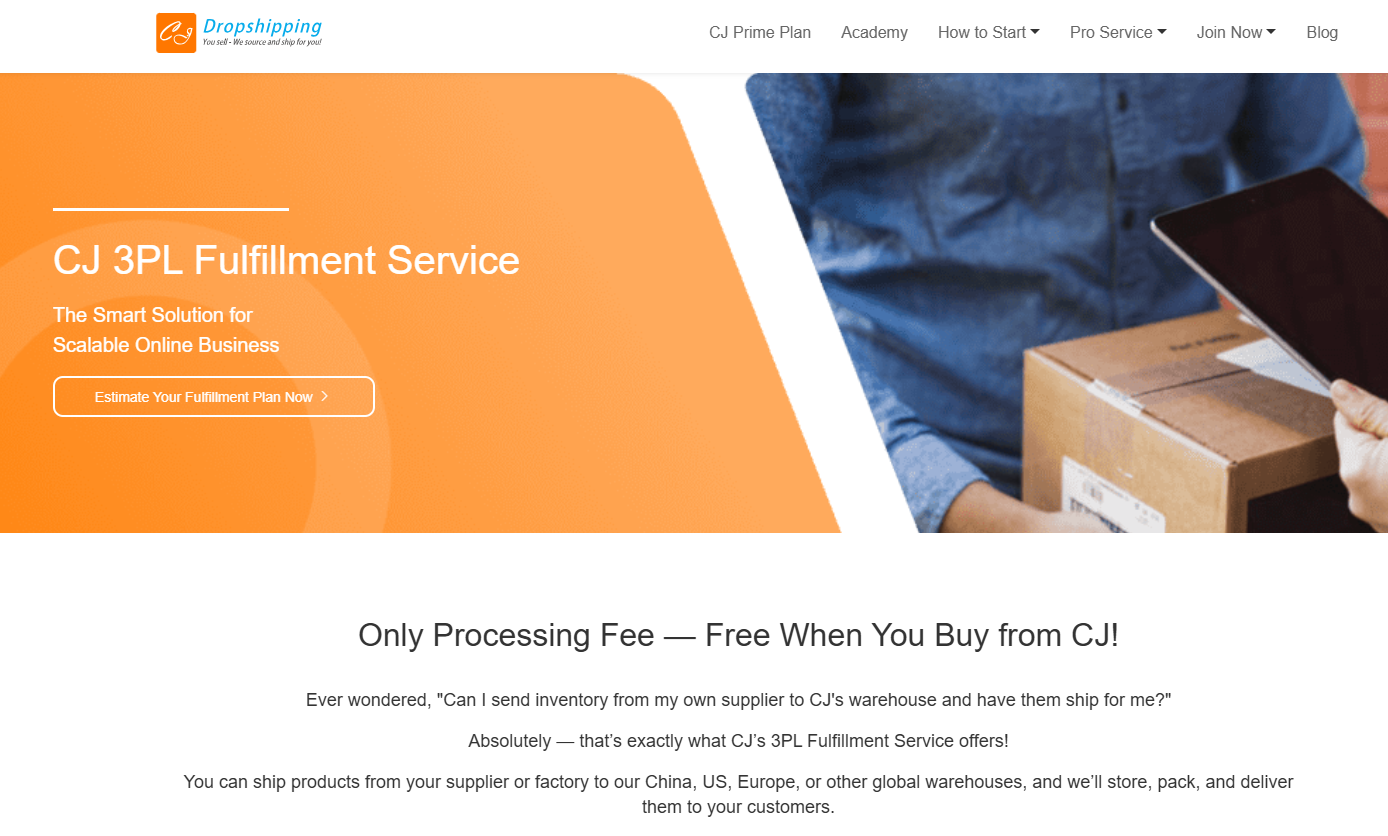
CJdropshipping features again here because it doubles as a 3PL-like solution for dropshippers. Over the years, CJ has built an extensive network of global warehouses – by 2025 they boast 50+ warehouses around the world (U.S., EU, China, Southeast Asia, etc.). What this means is that you can pre-stock inventory of your winning products in a warehouse near your customer base. For instance, if you have a hot seller in the US, you might buy, say, 100 units via CJ and store them in CJ’s New Jersey warehouse. Then those orders will ship domestically in the US in 3–7 days, instead of 2–4 weeks from China. CJ offers fast local delivery options by leveraging these warehouses, effectively acting as your fulfillment center. They manage the storage, packing, and shipping – you just pay the warehousing fee and shipping cost per order.
Even without pre-stocking, CJ’s warehouses come into play if you choose products that CJ already has in overseas warehouses. Many items on their platform can be shipped from the US or EU directly, which you can filter for when sourcing. This gives you the best of both worlds: the variety of Chinese sourcing, with the speed of local shipping.
Additionally, CJ provides services like quality control, custom packaging and branding, and even white-labeling of products. These are classic 3PL services. For example, CJ can help you add a branded thank-you card or logo sticker to your shipments, or conduct an extra quality inspection before sending an item out. They even have photography services to get professional product photos. All these extras help your store provide a better customer experience (on par with or better than if you ran your own warehouse). The advantage of using CJ as a fulfillment/3PL partner is that you don’t have to invest in your own warehouse or staff – you leverage their infrastructure on a per-order basis. To illustrate, many dropshippers use CJ’s US warehouse to store private inventory of an item that started as a dropship product; once it proved successful, they buy bulk via CJ to hold in the US. This reduces shipping times dramatically and can increase customer satisfaction and repeat purchase rates.
2.Spocket – Curated US/EU Supplier Marketplace
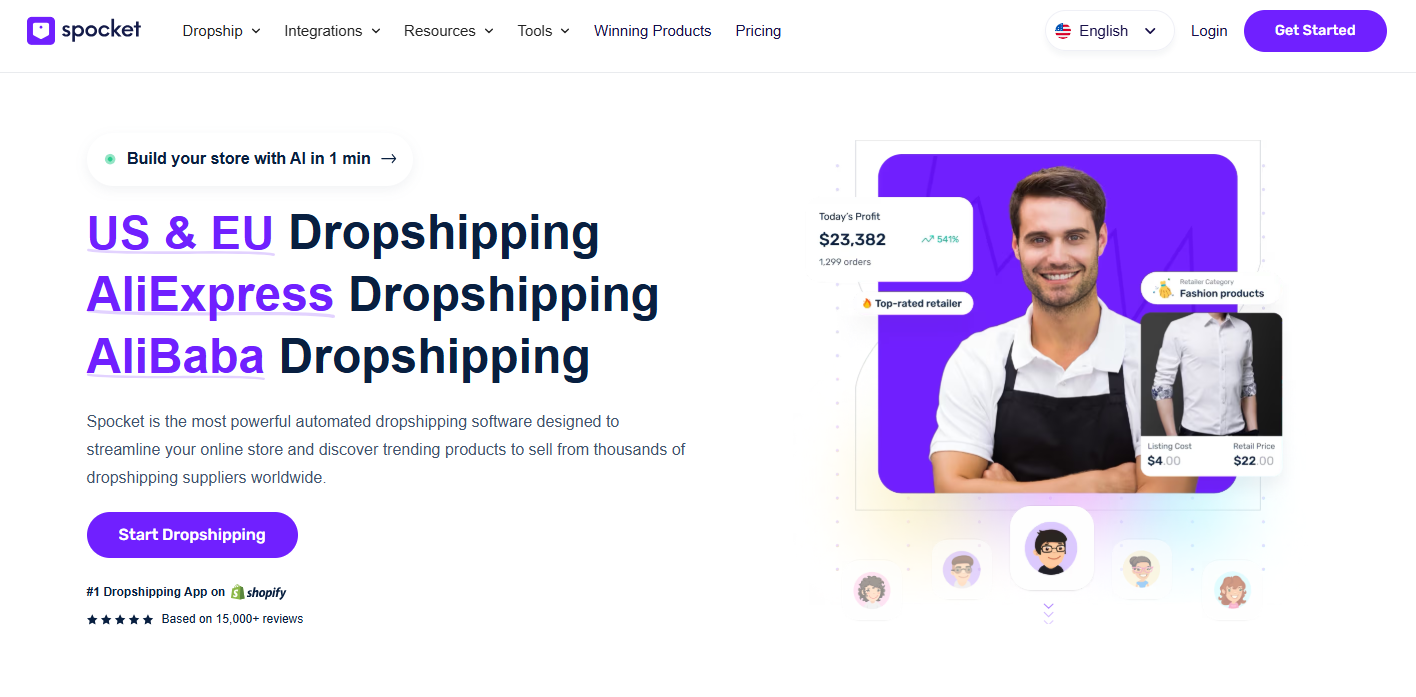
Spocket is a platform that connects you with high-quality dropshipping suppliers, predominantly in the US and Europe. It’s not a warehouse you stock yourself, but rather a marketplace of independent suppliers (often small manufacturers or brands) who are willing to dropship. For store owners, Spocket functions as a tool to source products that automatically come with fast shipping and trusted quality, since suppliers are local or regionally based. In Spocket’s catalog, you’ll find products ranging from apparel and home goods to personal care, all with indicated shipping origin and delivery estimates. According to Shopify, Spocket lets sellers browse over 7 million products from a global list of suppliers, and you can import them to your store with one click using the Spocket app.
The major appeal of Spocket is shipping speed and product uniqueness. Many Spocket suppliers offer 3-5 day shipping within their country/region (for example, a supplier in California shipping to U.S. customers). This can solve the biggest customer pain point in dropshipping: long delivery times. Additionally, because these suppliers are often original brands or wholesalers (not the mass-produced items all over AliExpress), you can find distinctive, premium products that not every dropshipper is selling. This could be artisan-crafted goods, boutique brand cosmetics, etc., which allows you to differentiate your store.
3.DropCommerce – High-Quality US/Canada Suppliers

DropCommerce is another platform focused on quality suppliers from North America. It’s similar in concept to Spocket but with an extra emphasis on vetting suppliers. DropCommerce only works with “real brands shipping from the US and Canada” – meaning they curate the suppliers to ensure they are legitimate businesses with good products (no junk or counterfeit items). As a result, the products you find on DropCommerce tend to be premium and priced accordingly, and you won’t have 100 sellers offering the exact same phone case. This curation can help your store stand out with unique inventory.
From a fulfillment perspective, DropCommerce offers some compelling guarantees. All products listed come with at least a 30% profit margin for retailers built in, so you can maintain healthy margins. They have 400+ suppliers in the US and Canada, and because the suppliers are domestic, customers in North America typically get their orders in about 3-5 days. Most suppliers also ship internationally if needed, but the sweet spot is serving the same-country audience for speed. DropCommerce integrates with Shopify, Wix, etc., so you can import products easily and route orders to the suppliers.
In essence, tools like Spocket and DropCommerce function as hybrid dropshipping-marketplace/3PL solutions. They vet and bring on suppliers with stocked inventory in target regions, and provide the tech to easily list those products on your store and fulfill orders seamlessly. This spares you from the complicated parts of working directly with individual local wholesalers (like negotiating contracts or figuring out integrations), since the platform standardizes it. If your growth strategy in 2025 includes improving shipping times or offering branded products, incorporating one of these fulfillment solutions is wise. They allow you to keep scaling (no need to warehouse goods yourself yet) while addressing two common dropshipping pain points: slow shipping and lack of branding.
Print-on-Demand (POD) Tools
Print-on-Demand is a special subcategory of dropshipping where the products are blank items (like t-shirts, mugs, phone cases, etc.) that get printed with your custom designs as orders come in. POD tools let you create and sell your own branded or creative products without holding any inventory – the printing happens on demand for each order. If you want to offer merchandise with unique designs, humor quotes, or custom branding, POD is the way to go. The following tools will help you design, list, and fulfill print-on-demand products easily.
1. CJdropshipping – POD Services with Global Fulfillment
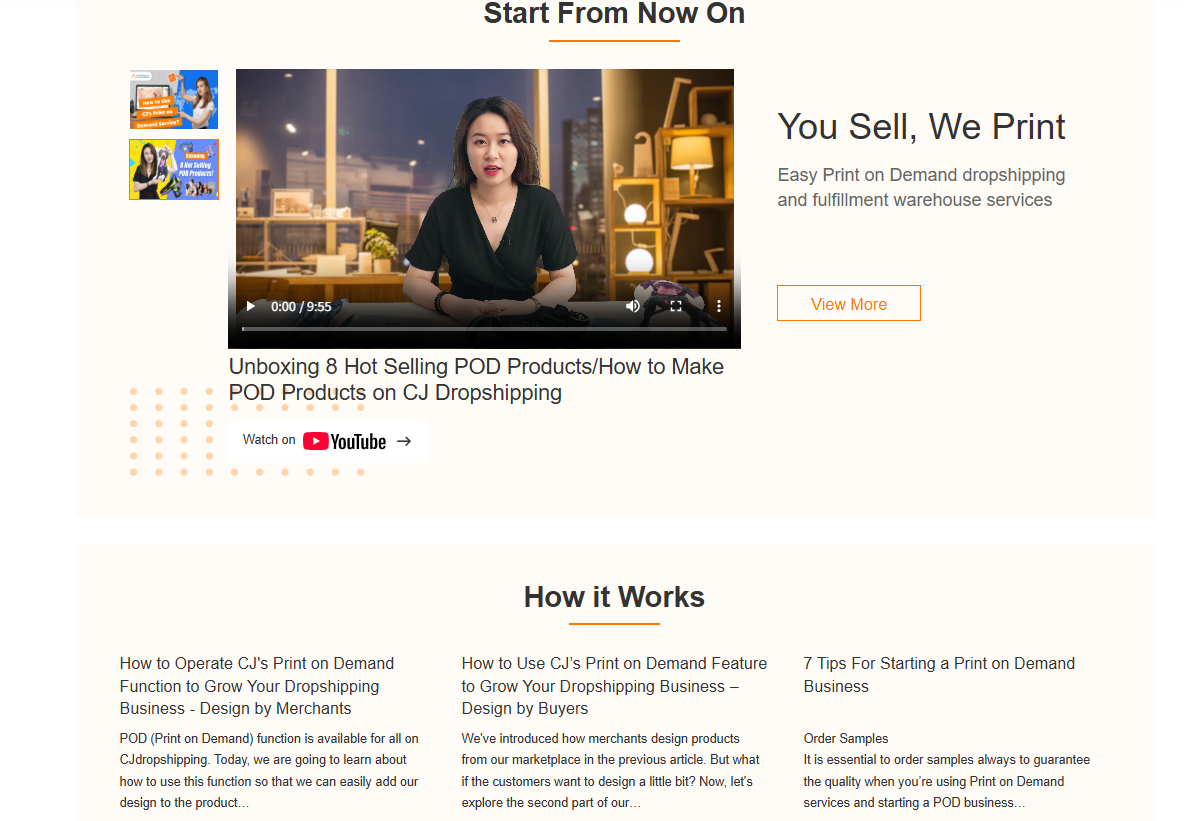
In addition to regular products, CJdropshipping also supports print-on-demand for certain items. They have a feature where you can upload your design or logo and apply it to a variety of products such as t-shirts, hoodies, coffee mugs, phone cases, jewelry, etc. CJ’s POD service stands out because it’s integrated with their overall platform. This means you can source your blank products via CJ’s suppliers (often at low cost), have CJ handle the printing of your design, and then ship it just like any other CJ order. It’s convenient to manage within one system, especially if you’re already using CJ for other dropshipping products.
CJ also allows product customization and branding beyond just standard POD printing. For example, you could have them brand the packaging or include custom inserts for your POD products, giving a professional touch. Because CJ has those global warehouses, they might print in the region closest to your customer for faster delivery (depending on the product and print facility availability). One of the biggest benefits here is that CJ doesn’t charge a subscription for using their POD – you pay per item (product + printing + shipping), keeping upfront costs low. So, if you want to experiment with offering a few custom products alongside your regular dropship items, CJdropshipping makes it easy and cost-effective to do so within the same dashboard.
2. Printful – High-Quality Print-on-Demand Fulfillment

Printful is one of the most popular pure-play POD companies out there. It specializes in top-quality products and printing, with a global fulfillment network. With Printful, you can design over 330 different products (as of 2025) – from standard apparel like shirts and hats to more niche items like embroidered aprons, all-over print yoga leggings, bean bag chairs, and so on. They handle printing, embroidery, and even engraving on some products.
One hallmark of Printful is its in-house production and quality control. They operate their own fulfillment centers in North America, Europe, Asia, and Australia, which means they control the printing process end-to-end. This results in consistently high quality prints and generally faster turnaround times for printing and shipping. For example, if an order is to the US, Printful usually produces it in their US facility and delivers in a matter of a few days (for many products around 2–5 business days shipping). Printful tends to be a bit pricier than some competitors, but you’re paying for that reliability and quality. They also excel in branding options: you can have inside shirt labels printed, add pack-ins (like stickers or flyers) to orders, and use custom packaging slips with your logo. It really allows a small seller to look like a much larger brand in the eyes of customers.
Another advantage is no upfront cost or subscription – you only pay when an order comes in (the cost of the blank product + printing + shipping). Printful’s pricing is not the cheapest per unit, but many sellers find it worth it because of fewer misprints and returns. They also have a robust integration with Shopify, WooCommerce, and many other platforms, making it seamless to push your designs as products to your store. Printful’s focus on premium quality and in-house fulfillment has earned it a reputation: as one comparison noted, “Printful focuses on high-quality products and in-house printing, while Printify offers affordability and flexibility”. In other words, choose Printful if you prioritize quality and brand consistency for your POD items.
3. Printify – Flexible Network of Print Providers

Printify is another leading POD platform, but with a different approach. Instead of doing printing themselves, Printify is a network of print providers around the world. When you create a product on Printify, you can choose which print provider (often which country or city) will fulfill it. For example, a simple white t-shirt might have 5 providers: some in the US, one in the UK, one in China, etc., each with slightly different pricing or brands of shirt. This model gives merchants a lot of flexibility and often lower base prices. You can select a provider based on cost, shipping speed to your customer’s region, or even particular print technology.
Printify’s catalog of products is huge – over 1000 products – because they aggregate what all their partners offer. You might find very unique items on Printify that aren’t on Printful due to this breadth (e.g. custom puzzles, or specific phone case models, etc.). Printify is generally known for more affordable pricing on the base products, which can mean better profit margins for you, especially if you subscribe to their Premium plan (around $29/month for up to 20% discount on all items). Many experienced POD sellers actually use both Printful and Printify: for example, Printful for items where quality is paramount, and Printify for expanding their product range or targeting different geographies at lower cost.
One thing to manage with Printify is consistency – since providers differ, the exact print quality or sizing can vary slightly. But Printify does allow sample orders and has a review system for providers, so you can choose reputable ones. It’s also worth noting that Printify doesn’t handle branding extras as deeply as Printful (some providers might allow custom pack-ins, but it’s not as standardized). However, Printify excels in product variety and cost-effectiveness: if your strategy is to offer a large selection of POD products or to maximize profit per item, it’s a fantastic tool. As a quick summary: Printful stands out for premium quality and integrated fulfillment, whereas Printify stands out for its wide catalog and flexibility through third-party providers. Both integrate well with major e-commerce platforms, both are very user-friendly in mocking up designs, and both are reliable in fulfilling orders. It really comes down to your store’s needs – many businesses even use them simultaneously to get the best of both.
In conclusion, POD tools let you become a product designer without any manufacturing. You can upload a clever graphic or slogan and instantly have it for sale on dozens of product types. When an order comes in, the POD service prints and ships it, and you profit from the difference between the retail price and the base cost. It’s a superb way to build a brand (like merch for your niche) or add unique items to your store that competitors can’t directly copy (since your designs are unique). Using CJ’s POD or dedicated services like Printful/Printify means you carry zero inventory and have no risk of unsold stock, yet you can offer potentially unlimited designs. Just keep in mind the importance of sample testing items (to ensure the print looks good) and factor in the slightly longer processing time for printing (usually a couple of days to print before shipping). Overall, adding print-on-demand to a dropshipping store in 2025 can be a powerful combo – you have your trending dropship products and your own branded products side by side.
Shipping & Tracking Tools
Once orders are shipped out, the experience isn’t over – both you and your customers want to know “Where’s my package?”. Shipping and tracking tools are all about providing transparency and efficiency in the post-purchase phase. They help aggregate tracking information from various carriers and present it in a clear way to you and your customers. This reduces customer anxiety (and “Where is my order?” support emails, often called WISMO tickets) and allows you to catch delivery issues early. Here are some top tools in this category:
1. AfterShip – Comprehensive Shipment Tracking Platform
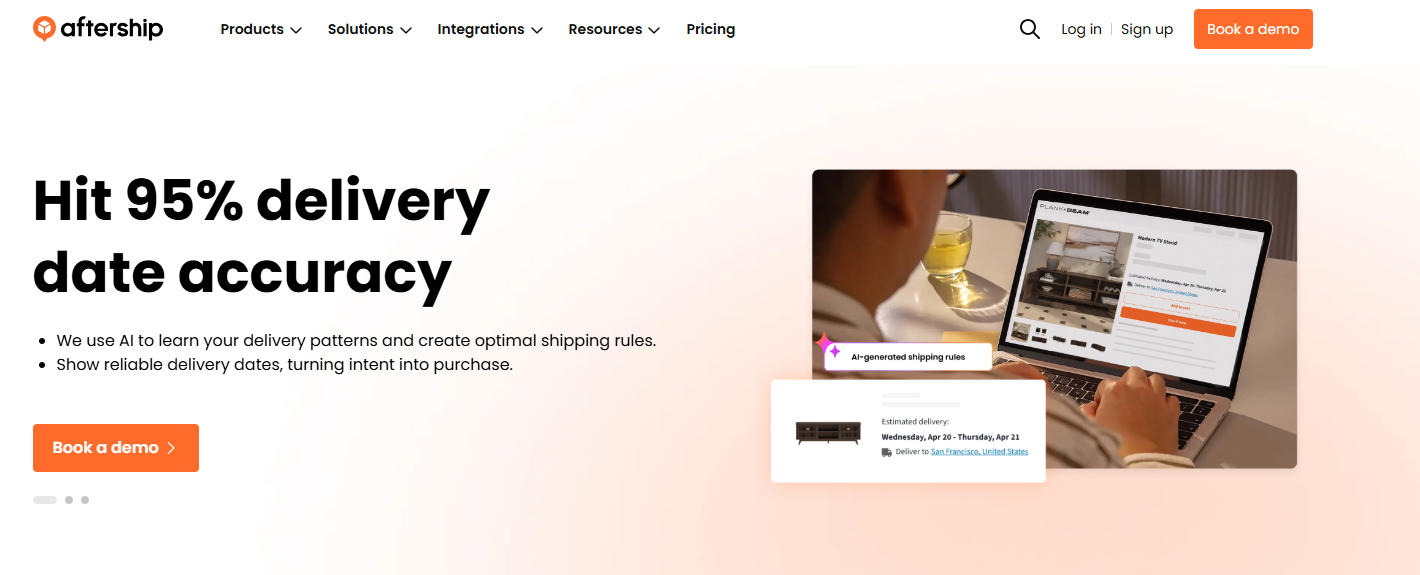
AfterShip is a well-known and widely used tracking solution that supports an impressive array of global carriers (over 1,200 carriers worldwide as of 2025). The core of AfterShip is a platform where you can track all your shipments in one dashboard, regardless of which carrier or country. For example, if you have some orders shipped by USPS, some by DHL, some by CJPacket, etc., AfterShip will pull the tracking data for each and normalize it into a unified format. This alone saves tons of time versus visiting each carrier’s website or dealing with language barriers on foreign postal sites.
For customers, AfterShip allows you to set up a branded tracking page on your own website. Instead of telling customers “track your package on DHL’s site”, you invite them to yourdomain.com/track (with your logo and style) where AfterShip displays the tracking updates. This keeps the customer in your ecosystem and reinforces your brand. AfterShip also provides automatic notifications – you can configure email or SMS updates to customers at key stages, like “In Transit”, “Out for Delivery”, “Delivered”, etc., all pulled from the carrier’s latest info. These proactive updates greatly reduce customers’ need to ask you about status.
2. ParcelPanel – Branded Order Tracking for Shopify & WooCommerce
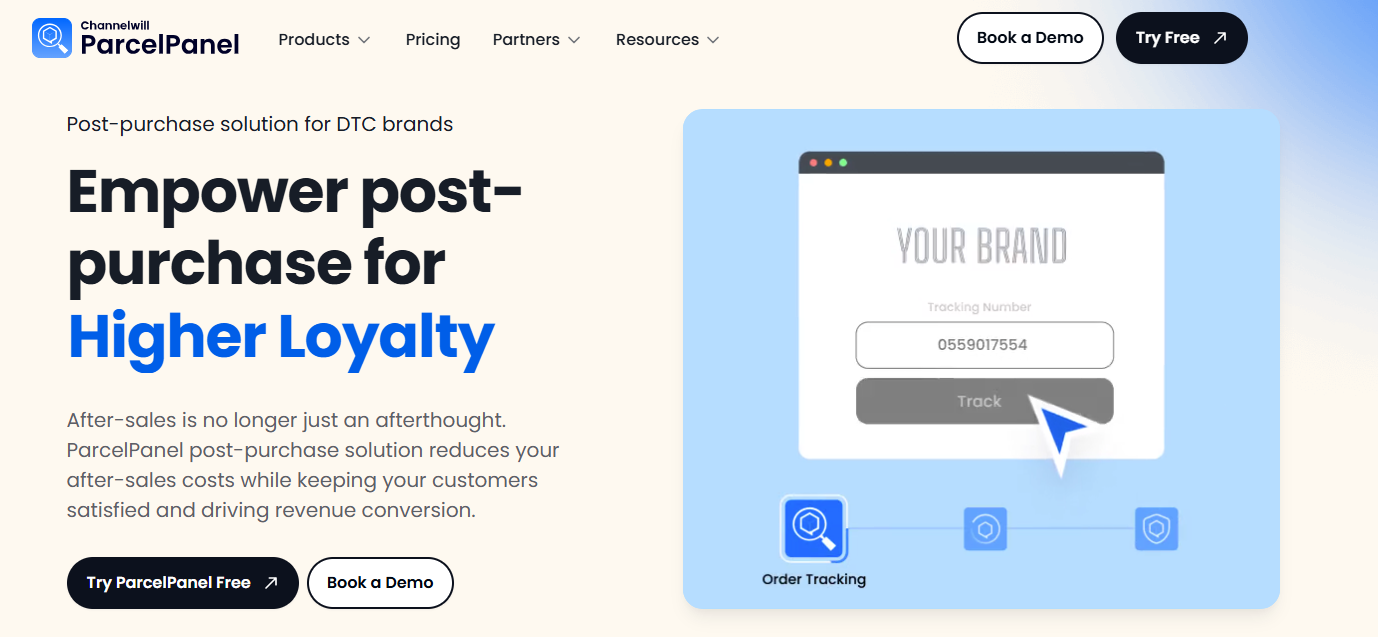
ParcelPanel is another excellent tracking solution, particularly popular among Shopify merchants. In fact, it’s often seen as a top AfterShip alternative with very similar features. ParcelPanel also supports over 1,200 carriers globally and provides real-time tracking updates and notifications. One of its selling points is ease of integration and a focus on dropshippers. ParcelPanel is designed to be plug-and-play with Shopify and WooCommerce, giving you a beautifully branded tracking page on your store without much setup fuss.
In comparisons, some have noted that ParcelPanel offers more out-of-the-box usability for non-technical users, whereas certain advanced features in AfterShip might need API knowledge. For example, ParcelPanel can automatically embed the tracking lookup on your Shopify order status page (so customers coming from their order confirmation email can track directly). It also supports more languages – 34 languages for tracking pages – which is great if you sell in multiple countries. The aim is to make the tracking experience as seamless and customized as possible for your brand. ParcelPanel even allows you to customize the tracking info that’s shown (they have a feature called Tracking Detail Replacement, which can simplify or prettify the sometimes technical tracking entries).
From a cost perspective, merchants often find ParcelPanel more cost-effective and flexible for small-to-mid businesses. It tends to have generous free and lower-tier plans. The platform emphasizes features like unlimited tracking on some plans, whereas AfterShip’s pricing scales with number of shipments (this may change, but it’s something to consider).
3. 17TRACK – Universal Tracking Platform (with App Integration)
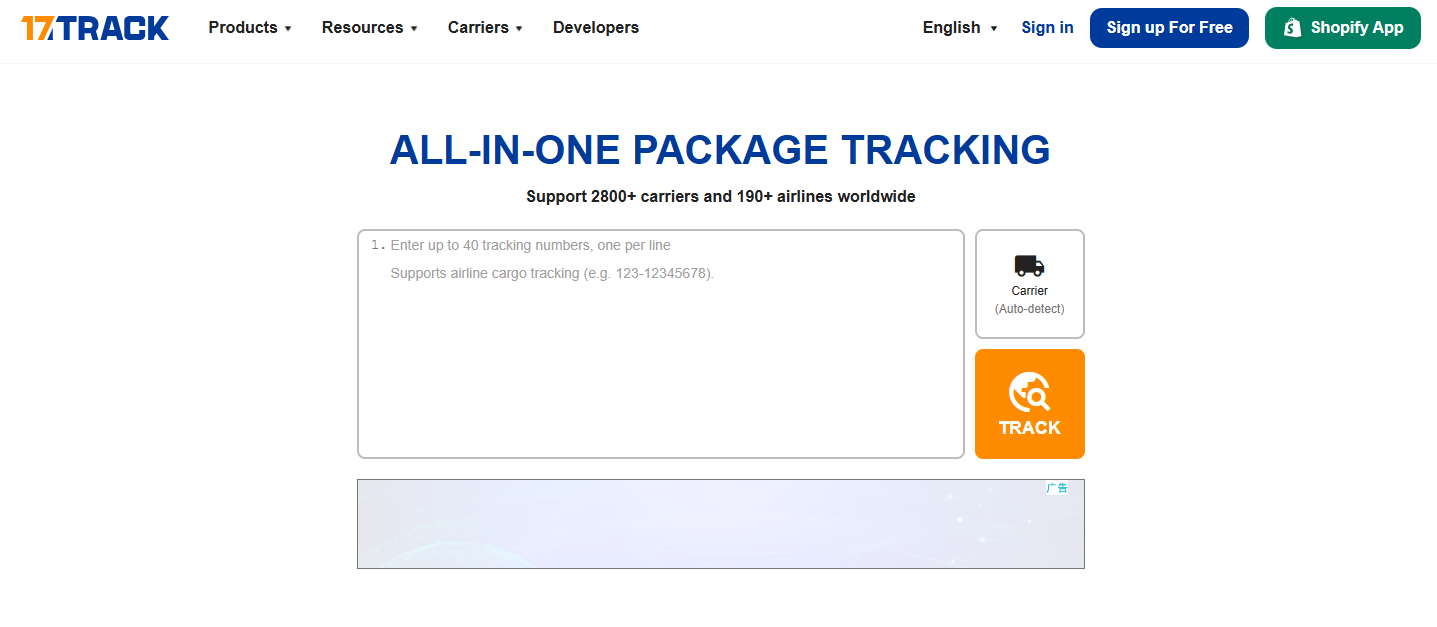
If you’ve ever bought something from AliExpress or a similar marketplace, you might have come across 17track.net. 17TRACK is a longstanding free universal tracking website that consumers use to track packages across numerous carriers. The great thing is, they also offer solutions for e-commerce stores, including a Shopify app and APIs. 17TRACK supports a whopping 2500+ carriers globally, arguably one of the most extensive in the industry. It’s known for reliably detecting even the most obscure postal tracking numbers and providing updates.
For a dropshipper, integrating 17TRACK means you can confidently track packages whether they’re handled by USPS, YunExpress, Canada Post, or a small regional courier. The Shopify app (if you use Shopify) allows you to embed a tracking lookup on your site. The interface is simple and straightforward, which can be ideal for small businesses that want a no-frills solution. It provides the latest status of a shipment and is available in multiple languages, catering to international customers.
One big advantage of 17TRACK is its cost: it offers a free plan that might be enough for many new dropshippers (with limitations on number of queries), and generally it’s very affordable to scale. It may not have all the marketing bells and whistles like branded recommendations on the tracking page or detailed analytics that AfterShip/ParcelPanel have, but it nails the core function: giving accurate tracking info. In fact, many merchants use 17TRACK in conjunction with other tools – e.g., use AfterShip for notifications but sometimes refer customers to the 17TRACK page when needed because it can auto-detect carriers so well.
In summary, shipping and tracking tools like AfterShip, ParcelPanel, and 17TRACK help you deliver a professional post-purchase experience. Instead of leaving customers in the dark or sending them long tracking codes to input on foreign postal sites, you give them an easy, branded way to know the status of their order. This goes a long way in building trust and loyalty. Customers appreciate knowing you’re on top of their delivery, and they’re less likely to complain or issue chargebacks due to “lost” packages (since they can see it’s en route). For you, these tools also provide peace of mind – you can monitor if a batch of orders is stuck in customs or if a particular shipping method is too slow and needs changing. Essentially, consider investing in a tracking solution as soon as you start getting regular orders; it’s one of those tools that directly impacts customer satisfaction and saves you time in customer service.
Marketing & Retention Tools
Driving traffic and converting sales is only half the battle – to maximize profitability, you also need to retain customers and encourage repeat business. Marketing and retention tools focus on engaging your shoppers through channels like email, SMS, and other personalized campaigns. They help turn one-time buyers into loyal customers and recover sales that might otherwise be lost (e.g., abandoned carts). Two of the best tools in this space for e-commerce are Klaviyo and Attentive.
1. Klaviyo – E-commerce Email & SMS Marketing Automation

Klaviyo has established itself as the gold standard for email marketing in e-commerce, and it has also expanded into SMS in recent years. It’s essentially a customer platform that collects data from your store (like who bought what, who viewed which product, etc.) and lets you build highly targeted marketing campaigns and automated flows from that data. With Klaviyo, even a small store can implement sophisticated segmentation and personalization that rivals big retailers. For example, you can set up segments like “customers who bought fitness products but not protein powder” or “VIP customers who spent over $500 in the last 6 months” and then send tailored messages to them.
One of Klaviyo’s killer features is its automation flows. These are pre-defined sequences of emails/SMS that trigger based on customer behavior. Common examples are: Abandoned Cart emails – when someone adds to cart but leaves, Klaviyo can automatically send a series of reminders (“You left something behind… here’s 10% off to complete your purchase”); Welcome Series – when a visitor signs up for your newsletter or creates an account, they get a warm welcome email, maybe introducing your brand story; Post-Purchase Follow-ups – after a purchase, you can send thank you messages, product review requests, or recommendations for related products after a certain time. Klaviyo makes setting these up very straightforward with a visual flow builder and lots of templates proven to work for e-commerce.
2. Attentive – SMS-First Marketing Platform
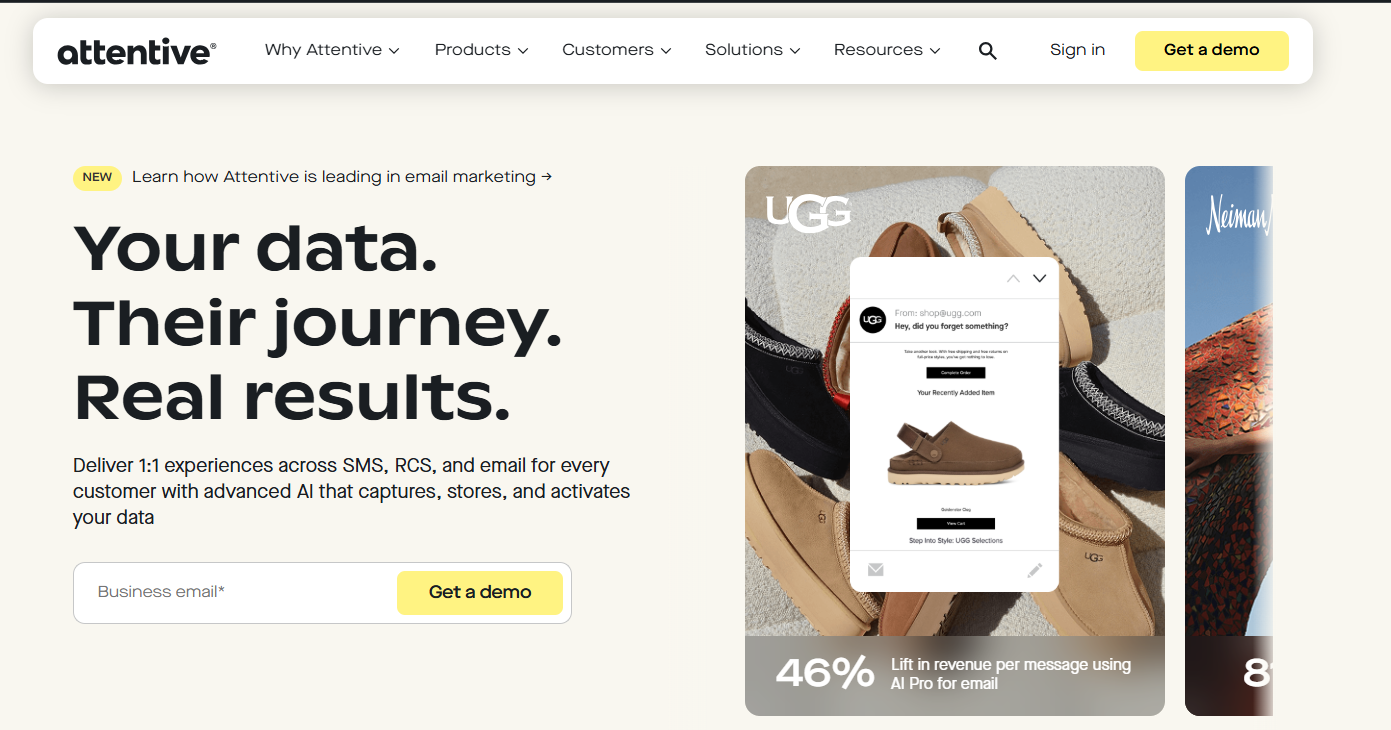
Attentive is a leading platform specifically for SMS marketing (text messaging), and it has recently also started offering email, but its core strength is in mobile messaging. If you’ve ever gotten a text from a retail brand with a promotion or shipping update, there’s a good chance Attentive was behind it – they’re used by over 5,000 brands, including many big names. The appeal of SMS marketing is the immediacy and high engagement: most texts are read within minutes. Attentive helps e-commerce merchants capitalize on this by providing tools for both mass texting campaigns and personalized 1:1 messaging.
One of Attentive’s signature offerings is the two-tap signup for SMS. For example, a visitor on your mobile site sees a 10% off offer if they subscribe; with two taps (one to open their SMS app with a prefilled number, one to send), they are opted-in. This low friction sign-up can grow SMS lists quickly. Once subscribed, Attentive allows you to create segments and automation similar to Klaviyo but via text. For instance, an abandoned cart SMS an hour after abandonment, which might say “Your cart is waiting – complete your purchase for 10% off: [short link]”. These often get a response or conversion from customers who ignored emails.
Attentive shines in rich personalization and compliance. They have advanced segmentation like Klaviyo – e.g., you could send a VIP customer a different text (maybe with a higher discount or early access) compared to a first-time browser. They also support MMS (multimedia messages), so you can include product images or GIFs in your texts for greater impact. Moreover, Attentive has a feature called Attentive Concierge, which is essentially a live-agent or AI hybrid that can respond to customer replies via SMS (for example, if someone texts back “I have a question about sizing,” your team or Attentive’s agents can handle that in real time). This can blur the line between marketing and customer service in a positive way – customers feel like they have a direct line to your brand.
Another important aspect is compliance: SMS is highly regulated (you need proper consent, opt-out language, etc.). Attentive builds compliance checks into the platform by default, helping ensure every message follows carrier and legal guidelines. This is crucial because non-compliant texting can lead to fines or getting messages blocked. Attentive basically acts like your legal ally, making sure each campaign is “by-the-book” so you can focus on content.
While Attentive is extremely powerful, it is generally positioned for larger or rapidly scaling brands – its pricing is typically higher and often based on usage (number of subscribers and messages). Many growing Shopify stores start with something like Klaviyo SMS (or SMSBump etc.) and then move to Attentive when they need more robust capabilities or dedicated support for SMS. In fact, a comparison noted that Attentive tends to be pricier and thus “suited to bigger, more established businesses… or those who use SMS as a primary revenue driver”. On the flip side, users often mention Attentive is a bit easier to set up and use for SMS than some email-first tools. So if SMS will be a major channel for you (for example, if you’re in a niche where text outreach is very effective, like fashion flash sales or local deliveries), Attentive could be the right choice even if it costs more, because the ROI from SMS can be substantial (e.g., 96% of marketers using text say it helped drive revenue, according to one report).
To wrap up, marketing & retention tools like Klaviyo and Attentive are critical for building a sustainable e-commerce business. Dropshipping stores historically suffered from low repeat purchase rates (people buy once from an ad and never return). But with these tools, you can change that: capture emails and phone numbers, send valuable content or offers, and keep your brand in customers’ minds. Even simple flows like an abandoned cart reminder or a thank-you coupon for next purchase can boost your revenue significantly. And as paid ads (Facebook, Google) become more expensive or unpredictable, having owned channels (email list, SMS list) is like owning your audience.
Pricing & Repricing Tools
Pricing your products correctly – and adjusting those prices as needed – can greatly affect your competitiveness and profit margins. This is especially true if you’re selling on marketplaces or if you have a lot of competitors selling similar items. Pricing tools help by monitoring the market and automating price changes based on rules or real-time data. Even for your own store, knowing competitor prices can inform your strategy (for example, undercut competitors or justify higher prices with better service). Here are two tools focused on pricing intelligence and repricing:
1. Prisync – Competitor Price Tracking & Dynamic Pricing

Prisync is a powerful tool designed for competitor price monitoring and dynamic pricing optimization. It’s used by e-commerce companies to literally keep an eye on what others are charging for the same products and then adjust their own prices accordingly. How it works: you input the products you want to track (this can often be done via URLs or SKUs), and Prisync will regularly scrape your competitors’ websites or marketplaces to record their prices and stock availability. You get a dashboard that shows, for each product, things like “Your price vs Competitor A vs Competitor B vs Competitor C” along with any changes. This real-time insight means no more manual checking or being blind to a competitor’s discount.
Where Prisync really shines is its repricing engine. You can set rules – for example, “Always price my product $1 below the lowest competitor, but not below $X minimum margin” or “If my price is the lowest and there’s room, increase it until I’m just $0.50 below the next guy.” The software then automatically updates your store’s prices when competitor prices change, following those rules. This kind of dynamic pricing ensures you are always competitive but not unnecessarily cheap. It’s especially valuable in marketplaces like Amazon or eBay where customers often sort by price and small differences can make or break the sale. For your own website, it helps if you’re in a niche where customers compare across multiple stores; staying within the market price range can improve conversion.
Prisync also provides alerts – e.g., if a competitor runs a big sale or if a new competitor enters – so you can react quickly. Another use case is monitoring MAP (Minimum Advertised Price) compliance if you work with brands that require it, but that’s less relevant to pure dropshipping. For dropshippers, the main benefit is protecting your margins and avoiding being undercut without manually scanning the web. One thing to note: Prisync is a premium tool often used by mid-sized to large retailers. It’s extremely useful if you have many SKUs that overlap with other sellers. If you’re selling unique products or your own designs, competitor pricing isn’t an issue; but if you’re selling, say, popular gadgets or branded items that others sell too, Prisync can be a game-changer.
2. Easync Repricer – Automation for Marketplace Dropshipping
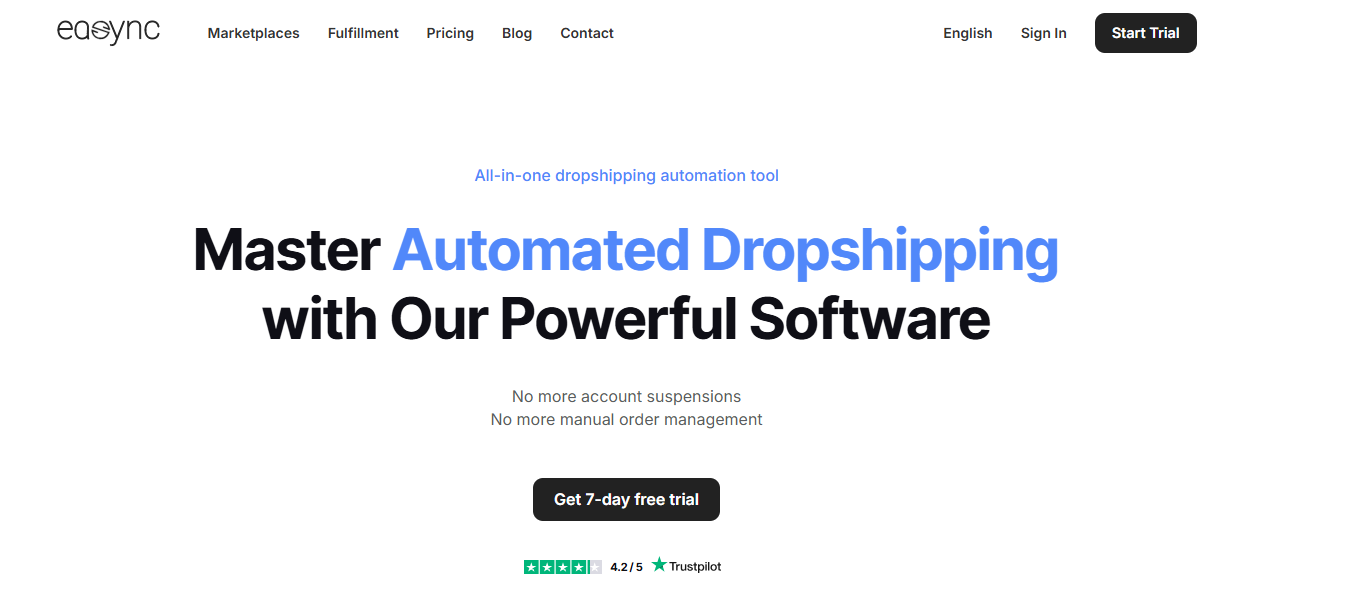
Easync is a tool primarily known in the eBay/Amazon dropshipping community. It’s an automation software that covers product import, order fulfillment, etc., but one of its core features is a repricer tailored for marketplace dropshipping. If you source from Amazon, Walmart, AliExpress, etc. and sell on eBay/Amazon, Easync helps keep your listings’ prices and stock in sync with the source. For example, if Amazon (the source) raises the price or goes out of stock, Easync can update your eBay listing’s price or stock within minutes, so you don’t sell at a loss or sell an unavailable item. This is crucial for retail arbitrage style dropshipping.
The Easync Repricer specifically will scan your supplier (source) prices every 15 minutes and also keep an eye on the marketplace competition. For instance, if you’re one of several sellers on an Amazon listing (as a merchant) or competing on an eBay search result, Easync can adjust your price to be the lowest by a small margin to win the buy box or attract the buyer. It essentially finds the lowest price currently offered and reprices your listing just enough to beat it (within limits you set). This can happen numerous times a day as others change their prices. Without a repricer, a human simply couldn’t keep up with that frequent change, especially when you have many listings.
Easync also helps with the flip side: making sure you don’t price too low. You configure your desired profit margin or markup formula, and it will only reduce price to the point where your margin floor is hit. This “protects your profit” while still maximizing competitiveness. For example, you might set a rule to always keep a 15% profit margin – if a supplier cost goes up, your listing price will automatically go up to maintain that margin.
In the world of Amazon dropshipping (which has its own challenges, but some still do it), repricers are indispensable because the “Buy Box” (the Add to Cart button on Amazon) rotates heavily based on price (and other metrics). A repricer like Easync updates your offers in near-real-time so you can win the buy box more often, resulting in more sales. On eBay, having the lowest price in search results for identical items can similarly boost your sell-through. Easync’s users have reported that its repricer helped them stay competitive without manually monitoring thousands of items daily – which is simply impossible to do manually at scale.
Keep in mind, repricing tools are mostly useful if price competition is a big factor in your business. If you run a standalone Shopify store selling unique curated products, you might not need automatic repricing; you might just do occasional manual adjustments based on sales performance. But if you’re listing commodity items in competitive marketplaces, a repricer is almost mandatory. It can literally be the difference between making sales or not, because if your price is even a bit higher than others, buyers have no reason to choose you (all else equal). Conversely, repricing ensures you’re not leaving money on the table by being far lower than the next competitor – it might nudge your price up if you are the only one selling a product or everyone else is priced much higher.
To summarize, pricing tools like Prisync and Easync give you control and agility in the pricing game. Dropshippers often operate on thin margins, so knowing what competitors charge and adjusting quickly can preserve your profitability. These tools are more advanced and might not be the first thing a beginner needs, but as you scale or if you enter competitive product categories, they become invaluable. They essentially leverage the power of algorithms to do something that humans can’t do effectively at scale: monitor the market non-stop and react instantly. If you reach that stage, the investment in such software usually pays for itself through either higher sales volume (by being more competitive) or higher margins (by identifying you could charge more when competitors are out of stock or priced higher).
Analytics & Optimization Tools
Knowledge is power, and that’s especially true in e-commerce. Analytics and optimization tools help you understand your store’s performance and visitor behavior, so you can make informed improvements. Rather than guessing why a page isn’t converting or which marketing channel is effective, you use data and user feedback. In 2025, two essential tools in this realm are Google Analytics 4 (the new standard for web analytics) and Hotjar (for visualizing user behavior on your site).
1. Google Analytics 4 (GA4) – Advanced Web & E-commerce Analytics
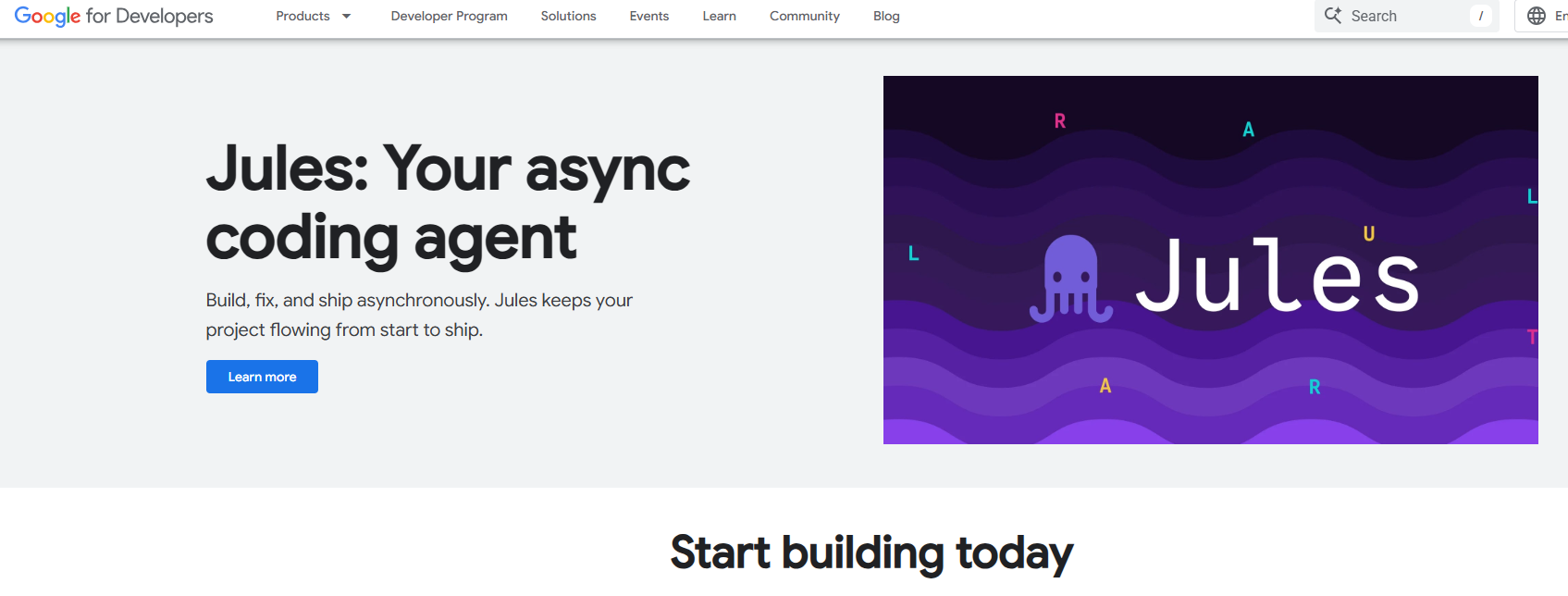
Google Analytics 4 is the successor to the old Universal Analytics (UA) and represents a major shift in how analytics is done. If you haven’t set it up yet, it’s critical to do so, because as of mid-2023 Google stopped collecting data in UA properties. GA4 is built to handle today’s multi-device, multi-event world. The biggest change is that GA4 is event-based, not session-based. In Universal Analytics, a lot of data was aggregated by sessions (visits) and pageviews. GA4 instead treats every interaction as an event – whether it’s a page view, a click, a purchase, or scrolling 90% down a page. This event-driven model is much more flexible and allows you to track the full customer journey in detail.
For example, in a dropshipping store context, you can track events likeview_product,add_to_cart,begin_checkout,purchase, etc., with parameters (like product ID, value, etc.). GA4 lets you see funnel reports that show drop-off points (e.g., what percentage of product viewers add to cart, and what percentage of those check out, etc.). It’s easier to spot where people are falling off in the buying process and then take action (maybe your shipping rates are shown at checkout and causing drop-off, for instance). GA4’s analysis hub allows you to create custom reports and even use exploratory data analysis techniques on your events.
Another strong point: cross-device and cross-platform tracking. GA4 can unify data from your website and app (if you have one) in one property, giving a single user view. Even if you just have a website, GA4 uses better identity tracking (it can use Google signals or your own user IDs if customers log in) to avoid double-counting users who, say, browse on mobile and then purchase on desktop. This helps you understand user behavior more accurately across devices – important because a lot of shoppers might first discover your site on mobile via social media but complete purchase on desktop, for example.
GA4 also incorporates machine learning for insights and predictions. It can automatically surface trends (like an increase in demand for a product) or predict metrics like churn probability or potential revenue from certain segments. For instance, GA4’s predictive audiences could help you target an email campaign to “likely repeat purchasers” based on its models. This is pretty advanced stuff that previously only large companies would do with data science; now it’s somewhat built-in.
One adjustment with GA4 is the interface – it’s different from UA and can be confusing initially. But it’s worth investing time to learn, because it promises deeper insights for e-commerce. You can customize a lot: define your own conversion events, create custom dimensions, etc., to get exactly the metrics that matter to you. And of course, GA4 remains free and extremely powerful. Be sure to also link it with Google Ads if you run ads, so you can see campaign performance and conversions seamlessly.
In a nutshell, GA4 helps you answer key questions: How are people finding my store? Which campaigns or traffic sources drive the most sales? What products or pages have the highest engagement? Where do users drop off the funnel? What’s the lifetime value or retention rate of customers? By acting on these insights (like improving pages with high drop-off or doubling down on marketing channels with good ROI), you continuously optimize your store’s performance.
2. Hotjar – User Behavior Heatmaps & Recordings
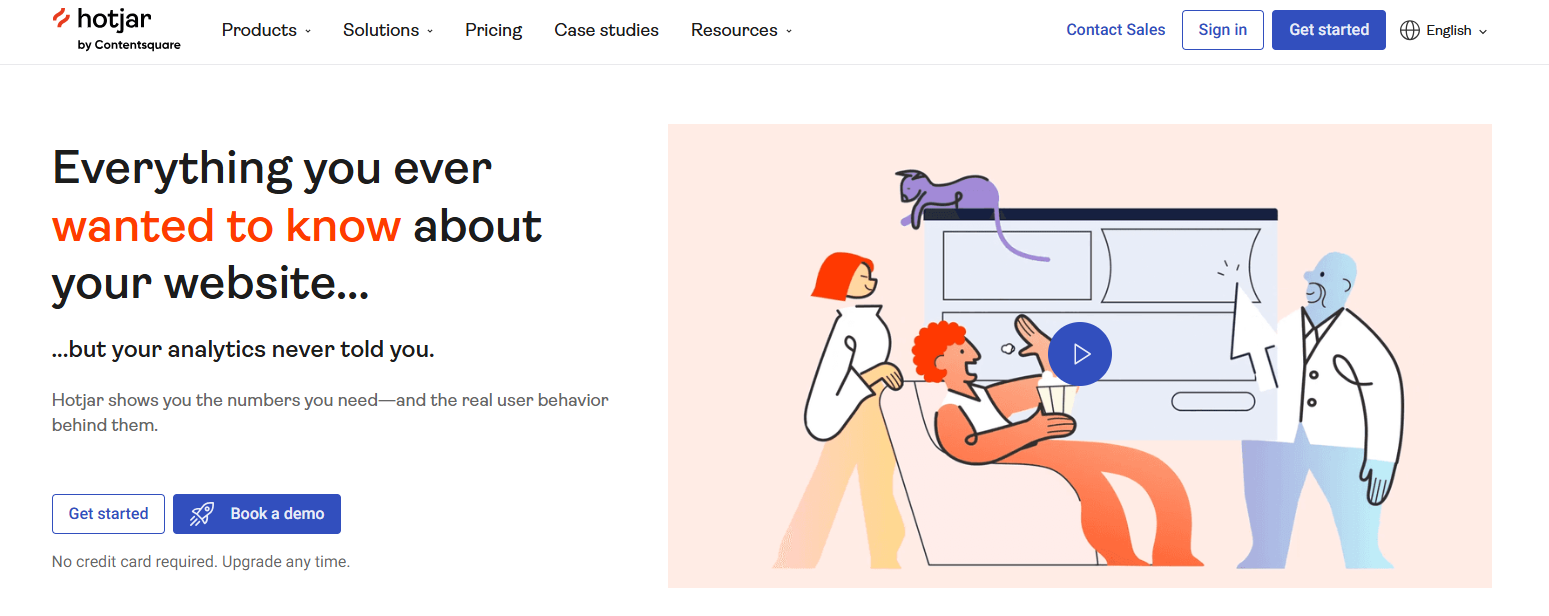
While GA4 tells you what is happening with numbers, Hotjar tells you how and why by showing actual user behavior on your site. Hotjar is a tool that provides heatmaps, session recordings, and user feedback polls to help you literally see how visitors interact with your website. It’s like looking over the shoulder of your customers as they browse.
-
Heatmaps: These are visual overlays on your pages that show where users click, how far they scroll, and how they move their mouse (which often correlates with attention). For example, a click heatmap might reveal that lots of users are clicking an image on your product page that isn’t actually clickable – that could tell you they want to zoom it or see more pictures, so maybe you should enable a zoom feature or make it a gallery. A scroll heatmap could show that only 25% of users scroll past the product description – if important info (like sizing or shipping details) is below that, many aren’t seeing it. You might then move that info higher or make the layout more engaging to encourage scrolling.
-
Session Recordings: Hotjar can record anonymized videos of individual user sessions on your site. You can watch as a user navigates pages, moves their mouse, clicks buttons, or hesitates. This is incredibly insightful for spotting UX issues. For instance, you might observe a user repeatedly clicking a coupon code field that isn’t working, or struggling to find the “Add to Cart” button because it’s placed awkwardly. Maybe they try to click on something that isn’t a link, or maybe they fill their cart and then drop off at checkout – by watching the recording you might notice it was because the shipping calculator took too long to load or the person tried an invalid discount code and got frustrated. Such observations are gold for improving your site’s usability.
-
Feedback Polls and Surveys: Hotjar also lets you deploy quick polls (e.g., “What stopped you from completing your purchase today?” or “How would you rate your experience on our site?”) either on-site or as external surveys. This direct feedback, when users provide it, can complement the behavioral data. Sometimes users will plainly tell you an issue – “The payment page kept giving an error,” or “Shipping cost is too high.” That saves you guesswork.
Using Hotjar, you essentially get to experience your store through the eyes of your visitors. It helps answer “why are users behaving this way?” For example, GA4 might tell you your product page has a high bounce rate. Hotjar could show that on mobile, the “Add to Cart” button is scrolling off screen or not easily tap-able – hence people leave. Or you might see users rage-clicking (clicking many times quickly) on an element – indicating frustration or that something appears clickable but isn’t functioning.
For conversion rate optimization (CRO), this is invaluable. Small tweaks informed by heatmaps/recordings – like moving a button, rewriting a confusing bit of text, streamlining a form – can lead to significant sales increases. Hotjar’s free plan allows a limited number of recordings and snapshots of heatmaps, which is usually enough for a small site to gather baseline insights. As you iterate, you can keep using it to test if the changes improved user engagement (e.g., a new heatmap after redesigning a page).
One thing to ensure: be mindful of privacy. Hotjar masks sensitive data by default (like it won’t record keystrokes in password fields, etc.), and you should follow GDPR or other regulations regarding user recording by perhaps mentioning it in your privacy policy. But when used correctly, it’s perfectly legitimate and extremely useful.
In summary, GA4 and Hotjar together give you a full picture: GA4 provides the quantitative metrics and overall performance data, while Hotjar provides qualitative insights into user experience. For a dropshipping store, where conversion rates can make or break profitability (especially if you’re paying for ads to get traffic), using these tools to continuously optimize is key. The best companies are always testing and refining their websites – you don’t need to aim for pixel-perfect design at launch, but you should observe how people actually use your site and refine accordingly. Over time, these improvements (like making the checkout smoother, or making your product pages answer all customer questions) can significantly boost your conversion rate and average order value, which means more revenue from the same traffic. That’s a huge win for your business.
Dropshipping Tools for Shopify
Shopify remains one of the most popular platforms to build a dropshipping store, and its App Store offers many specialized tools to enhance dropshipping operations. We’ve already touched on several (like DSers, Printful, etc.), all of which work with Shopify. In this section, we’ll highlight three top dropshipping apps on Shopify in 2025 and how they help store owners: the CJdropshipping Shopify app, Zendrop, and Spocket.
1. CJdropshipping App – All-in-One Dropshipping Solution on Shopify
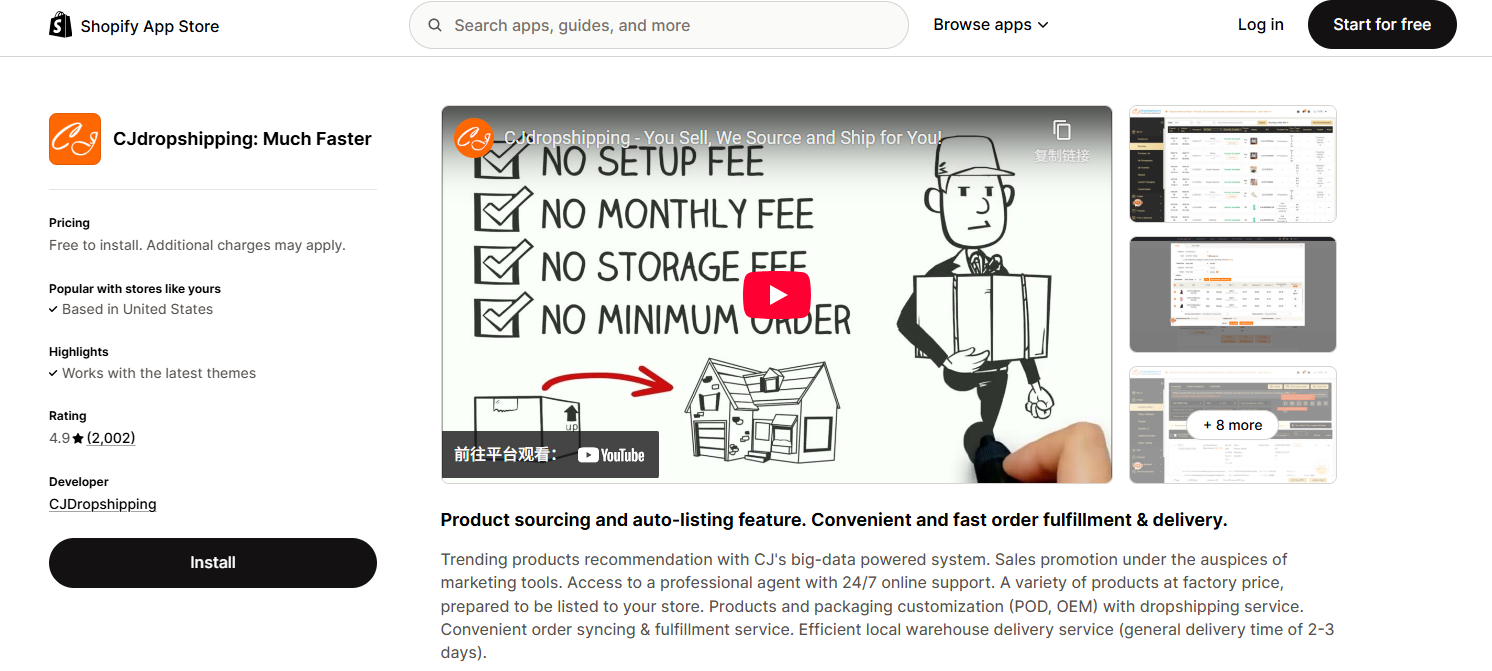
The CJdropshipping app for Shopify essentially brings the full power of CJ’s platform into your Shopify dashboard. With this app installed, you can browse CJ’s product catalog and import products to your store in one click, complete with all variants, images, and descriptions. It eliminates the need for a middleman like Oberlo (which is gone) or manual CSV uploads. CJ’s app also handles automatic order fulfillment: when an order is placed on your Shopify store, it can automatically sync to CJ, who will fulfill it and send the tracking back. This tight integration means running a dropshipping store feels much like running a print-on-demand store or similar – you focus on sales and marketing, while the app and CJ handle the supply chain.
What sets the CJ app apart from some generic alternatives is the breadth of services CJ offers through it. Not only do you get sourcing from AliExpress-like listings, but CJ also offers products sourced directly from 1688 and Taobao (Chinese marketplaces) which often have even lower prices, and they make those available to you in the app. This can give you a price advantage. Additionally, you can use the app to request custom product sourcing – if you found a unique product elsewhere, you can ask CJ to find it for you and list it. CJ also integrates features like bundle products, pre-orders, etc., and allows you to ship from their international warehouses by choosing the warehouse for each product in the app (for example, if you want a US-only shipping product, you’d choose the US warehouse variant).
Shopify merchants often praise the CJ app for reducing the app-juggling; instead of needing separate apps for sourcing, for tracking, for maybe print-on-demand, CJ covers a lot. Keep in mind, CJ is free to use (no monthly fee) – you pay per product cost and shipping when orders come, plus any optional services. This makes it very appealing, especially for new dropshippers on Shopify who want to keep costs low initially. If we compare, say, using AliExpress directly: you’d perhaps use DSers (which has a free basic plan too), but you might deal with multiple AliExpress vendors and inconsistent quality. With CJ’s app, you mostly deal with CJ as your one supplier/partner, which can simplify customer service and logistics.
In essence, the CJdropshipping Shopify App is a top choice for those who want an integrated dropshipping experience with a wide product range and added services (like faster shipping options, product customization, etc.). Many consider it a “one-stop dropshipping solution” for Shopify. It’s especially good if you plan to scale, since CJ can accommodate branding and bulk inventory when you get to that point, all through the same app.
2. Zendrop – Streamlined US & Global Dropshipping for Shopify
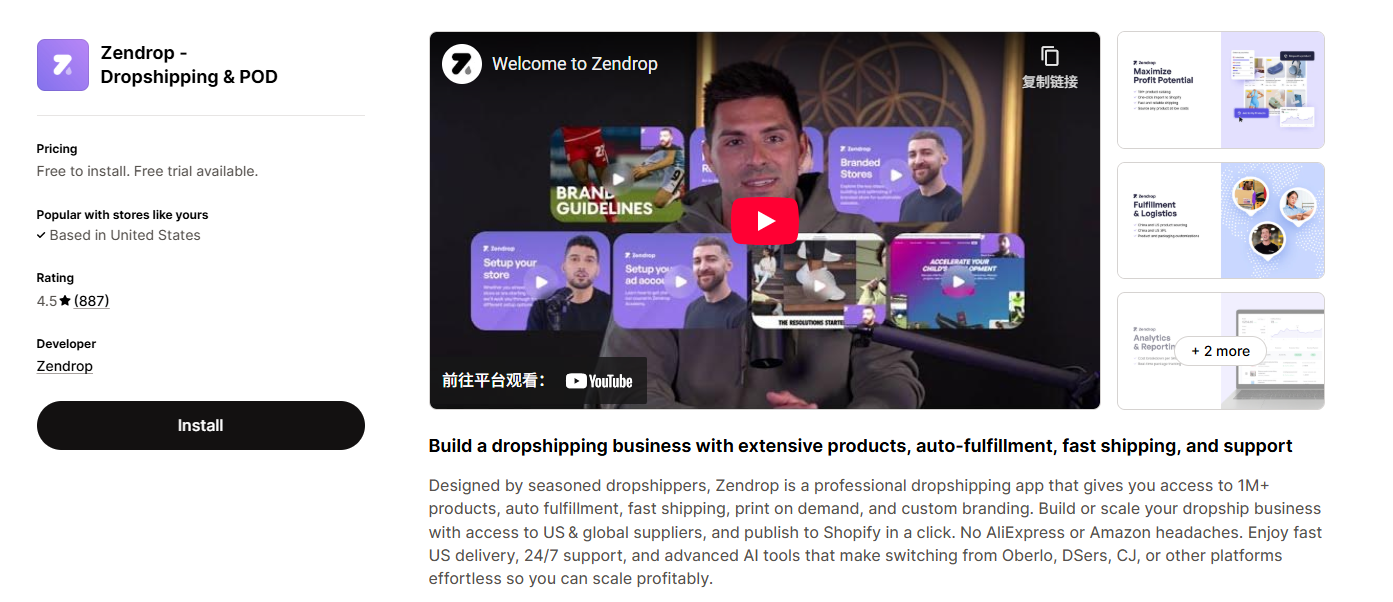
Zendrop is another popular Shopify dropshipping app known for its ease of use and focus on faster shipping options. Originally started by e-commerce entrepreneurs, Zendrop’s goal was to solve some pain points of AliExpress dropshipping. When you install Zendrop, you get access to over a million products that are available for auto-fulfillment through their platform. Many of these products are similar to what you’d find on AliExpress, but Zendrop works directly with suppliers (and has its own sourcing team) to ensure better quality control and often better shipping times.
One standout feature: Zendrop offers the option to bulk order inventory into their US warehouse for best-sellers. This means if you have a product that’s doing really well, you can pre-purchase, say, 100 units via Zendrop, they’ll store it in the US, and then orders to US customers will ship in 2-5 days. Even if you don’t bulk order, Zendrop has many items that they can ship from their own US-based stock or through expedited lines to get to customers in under a week. This is a huge advantage when marketing to, for example, American customers who expect Amazon-like delivery speeds.
Zendrop also focuses on the branding aspect: you can add your own branded packing slips, custom inserts, or even have your logo on the packages for many products. They’ve recognized that branding is key to building a long-term store (customers shouldn’t feel like they got a random item from China, but rather a package from your brand). They also support product bundling and subscription box creation – features that allow you to increase average order value by packaging products together or offering monthly mystery boxes, all handled via their fulfillment.
The app interface of Zendrop is often praised for being clean and beginner-friendly. They offer useful extras like “Trending Products” suggestions, an “Import List” to easily push products to Shopify, and one-click order fulfillment similar to others. Zendrop does have a cost – while it has a free plan for basic use, some advanced features (like Express shipping on some items, or extended automation) are in their paid plans. Notably, Zendrop doesn’t have a completely free forever plan for unlimited scale (unlike CJ which is free but per service fee). But many find the investment worth it because of time saved and customer satisfaction gained.
In summary, Zendrop is a top Shopify dropshipping app for those who want a more curated, branded, and faster-shipping experience than typical AliExpress. It’s like having a semi-private agent in China and the US handling things for you, but in a slick app form. If you had issues with long shipping times before, Zendrop is an answer to that, which can be a strong selling point when acquiring customers.
3. Spocket – Shopify Dropshipping for US/EU Products
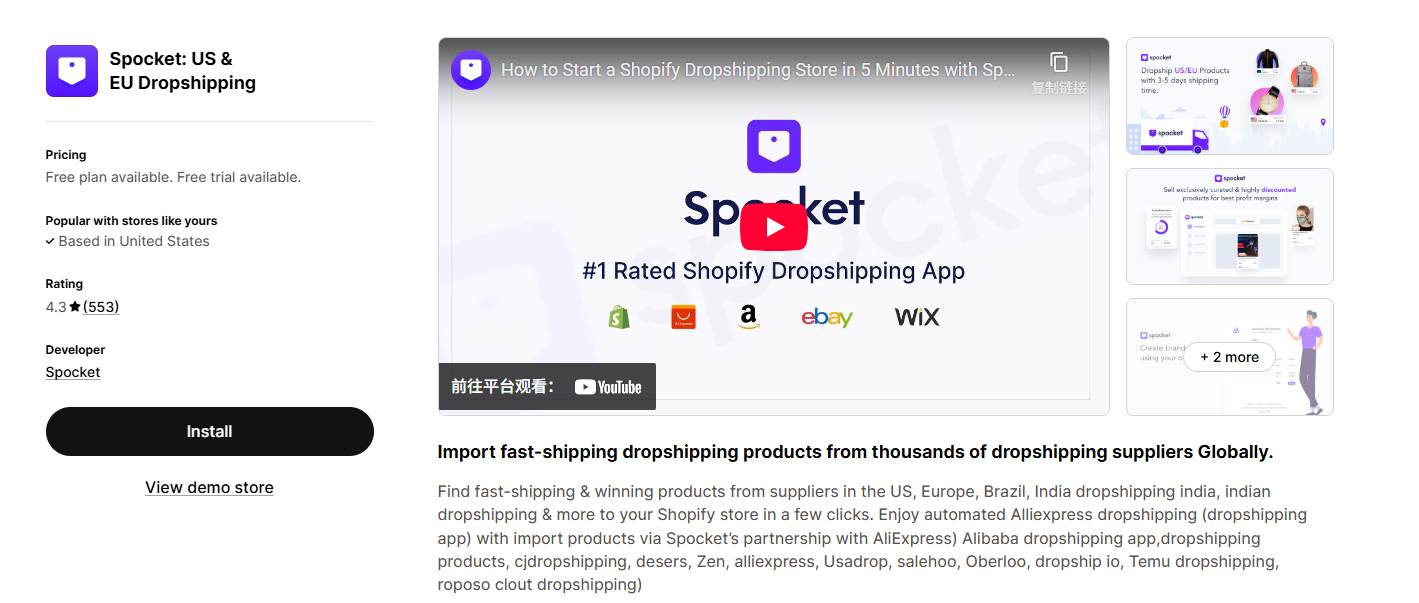
We discussed Spocket earlier in the fulfillment section, and indeed Spocket is also one of the best Shopify apps for dropshipping in 2025, particularly for sourcing US and EU based products. Via the Spocket Shopify app, you can in a couple of clicks add products from real, locally-based suppliers to your store and have orders forwarded automatically for fulfillment. The Shopify blog lists Spocket among the top suppliers, highlighting its global network and quick add-to-store functionality.
The reason Spocket is excellent for Shopify users is its focus on quality and shipping speed. Many Shopify entrepreneurs want to differentiate from the typical “coming from China in 3 weeks” model. Spocket gives you a catalog of items (like handmade soaps from a US vendor, or fashion from a European boutique supplier) where shipping times might be 3-5 days domestic. This can dramatically improve customer satisfaction and perceived value. Plus, because products are often unique or from lesser-known brands, you aren’t competing with dozens of identical Amazon listings; you can build a niche brand around them.
From within Shopify, Spocket handles inventory sync and pricing updates. If a supplier updates stock, your store reflects it. When a customer orders, you pay the wholesale price to the supplier through Spocket and they send it out. Spocket’s emphasis on domestic suppliers in various countries also means you can find items for multiple markets (e.g., source some products from US suppliers for US customers, and others from EU suppliers for EU customers, reducing international shipping). They also provide the ability to order samples easily, which is important for quality assurance.
For beginners, Spocket has a 7-day free trial and then various plans. It’s not free long-term; you invest in it as a service to get access to those vetted suppliers. The ROI can be great if you pick the right products, because you can charge a premium for items that are higher quality and shipped fast, compared to generic goods. According to user reviews, Spocket is recommended for those who want to sell products from domestic suppliers to reduce delivery times, and they mention the branded invoicing feature as a plus.
In essence, on Shopify, Spocket is the go-to app for finding reliable, fast-shipping suppliers in the US, Europe, and other regions. It pairs well with a strategy where your store’s value prop is quality and fast delivery. Think of a store selling, say, eco-friendly candles from a US artisan and boutique jewelry from a UK designer – Spocket could supply those seamlessly. The key limitation is you might have slightly higher wholesale costs and possibly need to subscribe to a plan, but the trade-off is a branded, customer-pleasing experience that can allow you to price for a higher margin.
As we’ve covered, Shopify’s ecosystem is rich with dropshipping apps. CJdropshipping, Zendrop, and Spocket rank among the best because they each tackle the main challenges in dropshipping: CJ offers breadth and infrastructure, Zendrop offers streamlined process and faster shipping from China, and Spocket offers high-quality local sourcing. Depending on your store’s focus, you might use one or even a combination (some people use Spocket for certain products and CJ for others, for instance). The beauty of Shopify is you can mix and match apps to tailor the supply chain that fits your brand. Just be careful not to overcomplicate – it’s usually best to start with one primary app and expand only if needed. Each of these apps has proven themselves by 2025 to be reliable partners for scaling a dropshipping store on Shopify.
By now, it’s clear that dropshipping in 2025 isn’t about doing everything manually or in the dark – it’s about leveraging these powerful tools to run a smarter, faster, and more customer-centric business. Whether you’re just launching your first store or looking to scale an existing one, the right combination of tools (tailored to your strategy) can provide a serious competitive edge. Use this guide as a reference, start with the essentials, and gradually incorporate more as needed. With deep insights and automation on your side, you’ll be well-equipped to grow your online store successfully. Happy dropshipping!
FAQ
Q: Can I start a dropshipping store without paying for all these tools upfront?
A: Yes – many essential dropshipping tools offer free plans or trials, so you can get started with minimal cost. For example, CJdropshipping is free to sign up and use (you only pay the cost of products and shipping when you get orders). Shopify itself has a free trial.
Q: I’m new – which dropshipping tools should a beginner prioritize first?
A: For a beginner, the must-haves are usually: (1) a product sourcing/automation tool (so you can import products easily and fulfill orders without headaches), (2) a marketing tool to capture customer emails or phone numbers, and (3) an analytics tool to track performance. A great starter combo for a Shopify store is something like CJdropshipping or DSers for product import & fulfillment, Klaviyo for email marketing (start building your email list from day one with a popup offering a discount), and Google Analytics 4 for traffic and conversion tracking.
Q: Do I need to use every type of tool mentioned in this guide?
A: Not necessarily. The toolkit you need depends on your business model, scale, and pain points. Think of this guide as an overview of possibilities – you should pick and choose the tools that solve your current challenges.
Q: How do these dropshipping tools integrate with my store – is it hard to set up?
A: Most reputable dropshipping tools and apps today are designed to be user-friendly and offer straightforward integrations. If you’re on Shopify (or another major platform like WooCommerce), it’s usually as simple as installing an app and following a login or API connection prompt. For example, installing the CJdropshipping app from Shopify App Store will prompt you to create or log into a CJ account, and then your Shopify store is linked – from there, importing a product or syncing an order is mostly one-click operations.
Q: How can I trust that a supplier found via these tools is reliable?
A: It’s wise to do a bit of due diligence on suppliers even when using these tools. Many dropshipping platforms like CJdropshipping, and Tradelle vet their suppliers and have ratings or reviews in place. For instance, CJdropshipping manages fulfillment themselves for many products, and they perform quality control checks on orders, so you’re largely trusting CJ’s internal processes (CJ has a reputation to uphold, so it’s in their interest to keep quality consistent).

